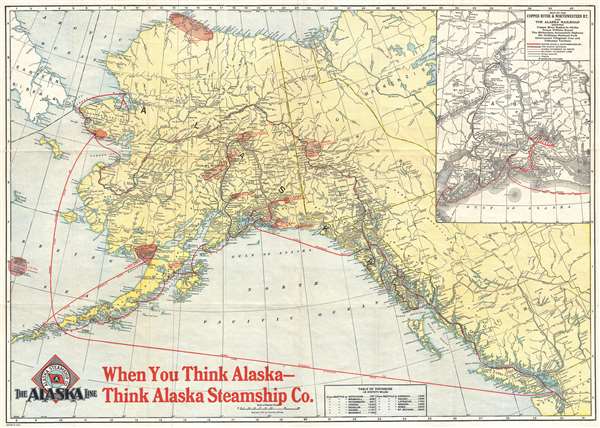
This item below is out of stock, but another example (left) is available. To view the available item, click "Details."
Details
1929 Poole Brothers Map of Alaska and Alaska Steamship Company Routes
1929 (dated) $450.00
1917 Poole Brothers Map of Alaska and Alaska Steamship Company Routes
AlaskaSteamship-poolebros-1917
Title
1917 (dated) 22.5 x 31.5 in (57.15 x 80.01 cm) 1 : 4500000
Description
The two major routes of the Alaska Steamship Company are illustrated in red, the Inside Route, which ventured up the Pacific coast to Skagway, Valdez, and Seward, and the Nome and St. Michael route. Innumerable towns are labeled throughout Alaska, along with mountains and mountain ranges, rivers, islands, bays, and islets. The Copper River and Northwestern Railroad and the Alaska Railroad are depicted both on the central and in an inset map situated on the upper right. The inset map details the route of the Copper River and Northwestern from Seward to Fairbanks and the Alaska from Cordova to Kennecott. The inset map also notes the military telegraph lines, stage routes, and wireless stations. A table of distances from Seattle to thirteen different locations in Alaska is included along the bottom border.
This map was produced by the Poole Brothers Company of Chicago to promote the Alaska Steamship Company.
Cartographer
Poole Brothers (1878 - 1968) were a Chicago based firm active in the late 19th and early 20th century with an initial focus on promotional railroad maps. Poole Brothers was founded by George Amos Poole (March 20, 1843 – September 7, 1918). In 1868, Poole, along with his uncle William H. Rand (1828 - 1915) and Andrew McNally (1836 - 1904), purchased the Chicago Tribune's job printing plant and formed the firm Rand McNally. In 1878, he left Rand McNally to form, with his brother William H. Poole, Poole Brothers, a direct competitor to Rand McNally for the lucrative railroad business. Like many of its competitors, Poole Brothers maintained an office on Chicago's Printer's Row (downtown Loop district). Their earliest known work is an 1880 map of Yellowstone National Park. In 1887, Poole Brothers, Andrew McNally, and several others formed the United Typothetae of America, a master printers association. In 1848, they were cited, along with Rand McNally and George Cram, by the Federal Trade Commission for price fixing. Their earliest known work is an 1880 map of Yellowstone National Park. Afterward they went on to produce a vast range of maps and other print products including tickets, cards, coupons, and restaurant menus. In time Poole Brothers merged with Newman-Randolph, which was then acquired by the American Can Company in the early 1960s. The American Can Company liquidated its printing concerns later in the same decade. More by this mapmaker...

